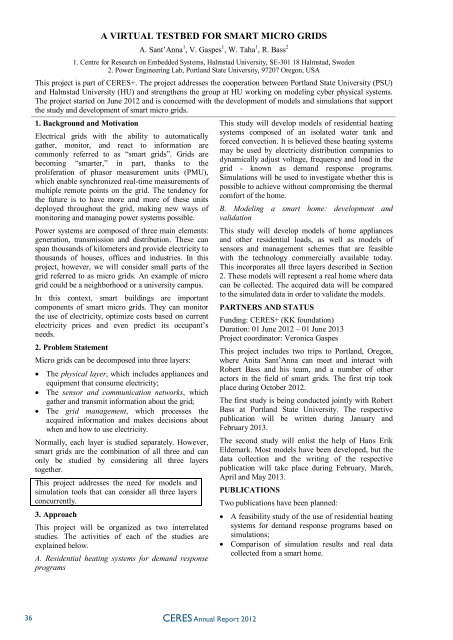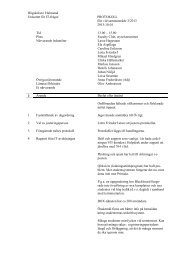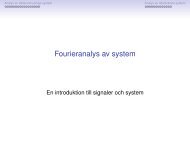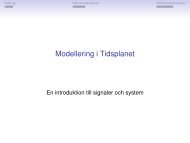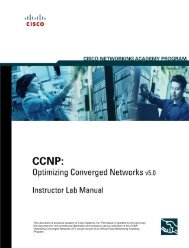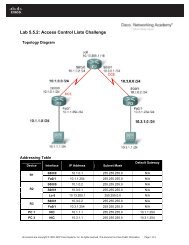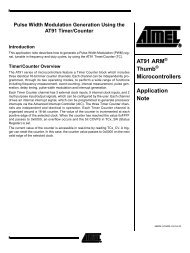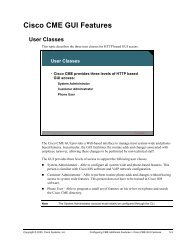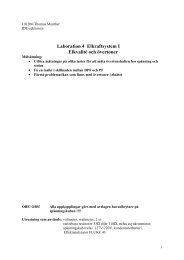ANNUAL REPORT 2012
ANNUAL REPORT 2012
ANNUAL REPORT 2012
Create successful ePaper yourself
Turn your PDF publications into a flip-book with our unique Google optimized e-Paper software.
A Virtual Testbed for Smart Micro Grids<br />
A VIRTUAL TESTBED FOR SMART MICRO GRIDS<br />
A. Sant’Anna 1 , V. Gaspes 1 , W. Taha 1 , R. Bass 2<br />
1. Centre for Research on Embedded Systems, Halmstad University, SE-301 18 Halmstad, Sweden<br />
2. Power Engineering Lab, Portland State University, 97207 Oregon, USA<br />
This project is part of CERES+. The project addresses the cooperation between Portland State University (PSU)<br />
and Halmstad University (HU) and strengthens the group at HU working on modeling cyber physical systems.<br />
The project started on June <strong>2012</strong> and is concerned with the development of models and simulations that support<br />
the study and development of smart micro grids.<br />
1. Background and Motivation<br />
Electrical grids with the ability to automatically<br />
gather, monitor, and react to information are<br />
commonly referred to as “smart grids”. Grids are<br />
becoming “smarter,” in part, thanks to the<br />
proliferation of phasor measurement units (PMU),<br />
which enable synchronized real-time measurements of<br />
multiple remote points on the grid. The tendency for<br />
the future is to have more and more of these units<br />
deployed throughout the grid, making new ways of<br />
monitoring and managing power systems possible.<br />
Power systems are composed of three main elements:<br />
generation, transmission and distribution. These can<br />
span thousands of kilometers and provide electricity to<br />
thousands of houses, offices and industries. In this<br />
project, however, we will consider small parts of the<br />
grid referred to as micro grids. An example of micro<br />
grid could be a neighborhood or a university campus.<br />
In this context, smart buildings are important<br />
components of smart micro grids. They can monitor<br />
the use of electricity, optimize costs based on current<br />
electricity prices and even predict its occupant’s<br />
needs.<br />
2. Problem Statement<br />
Micro grids can be decomposed into three layers:<br />
The physical layer, which includes appliances and<br />
equipment that consume electricity;<br />
The sensor and communication networks, which<br />
gather and transmit information about the grid;<br />
The grid management, which processes the<br />
acquired information and makes decisions about<br />
when and how to use electricity.<br />
Normally, each layer is studied separately. However,<br />
smart grids are the combination of all three and can<br />
only be studied by considering all three layers<br />
together.<br />
This project addresses the need for models and<br />
simulation tools that can consider all three layers<br />
concurrently.<br />
3. Approach<br />
This project will be organized as two interrelated<br />
studies. The activities of each of the studies are<br />
explained below.<br />
A. Residential heating systems for demand response<br />
programs<br />
This study will develop models of residential heating<br />
systems composed of an isolated water tank and<br />
forced convection. It is believed these heating systems<br />
may be used by electricity distribution companies to<br />
dynamically adjust voltage, frequency and load in the<br />
grid - known as demand response programs.<br />
Simulations will be used to investigate whether this is<br />
possible to achieve without compromising the thermal<br />
comfort of the home.<br />
B. Modeling a smart home: development and<br />
validation<br />
This study will develop models of home appliances<br />
and other residential loads, as well as models of<br />
sensors and management schemes that are feasible<br />
with the technology commercially available today.<br />
This incorporates all three layers described in Section<br />
2. These models will represent a real home where data<br />
can be collected. The acquired data will be compared<br />
to the simulated data in order to validate the models.<br />
PARTNERS AND STATUS<br />
Funding: CERES+ (KK foundation)<br />
Duration: 01 June <strong>2012</strong> – 01 June 2013<br />
Project coordinator: Veronica Gaspes<br />
This project includes two trips to Portland, Oregon,<br />
where Anita Sant’Anna can meet and interact with<br />
Robert Bass and his team, and a number of other<br />
actors in the field of smart grids. The first trip took<br />
place during October <strong>2012</strong>.<br />
The first study is being conducted jointly with Robert<br />
Bass at Portland State University. The respective<br />
publication will be written during January and<br />
February 2013.<br />
The second study will enlist the help of Hans Erik<br />
Eldemark. Most models have been developed, but the<br />
data collection and the writing of the respective<br />
publication will take place during February, March,<br />
April and May 2013.<br />
PUBLICATIONS<br />
Two publications have been planned:<br />
A feasibility study of the use of residential heating<br />
systems for demand response programs based on<br />
simulations;<br />
Comparison of simulation results and real data<br />
collected from a smart home.<br />
36 CERES Annual Report <strong>2012</strong>


